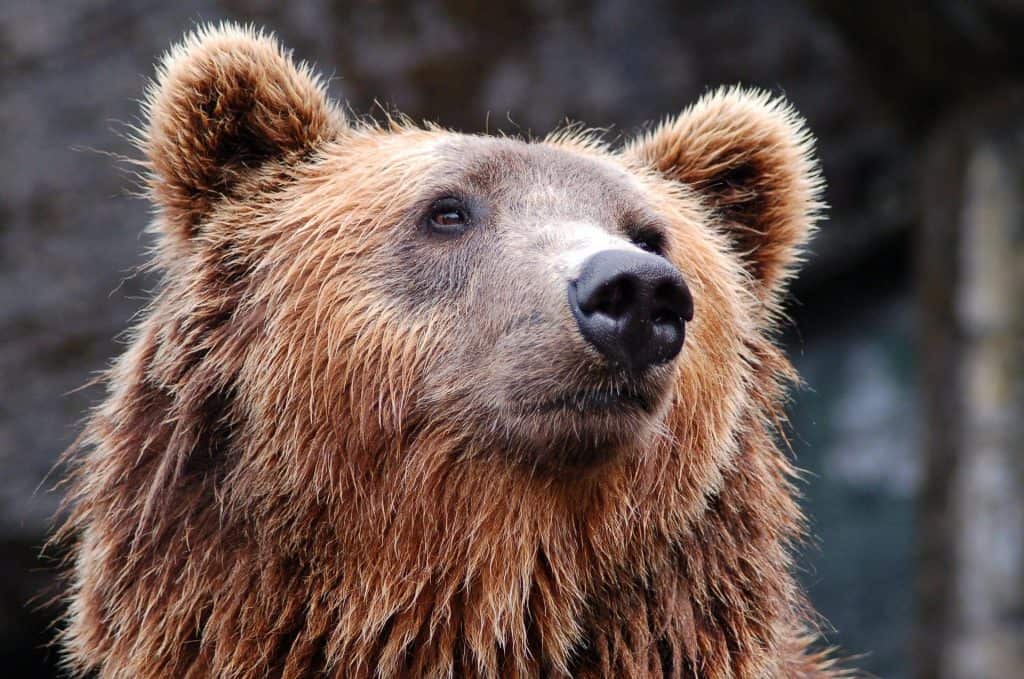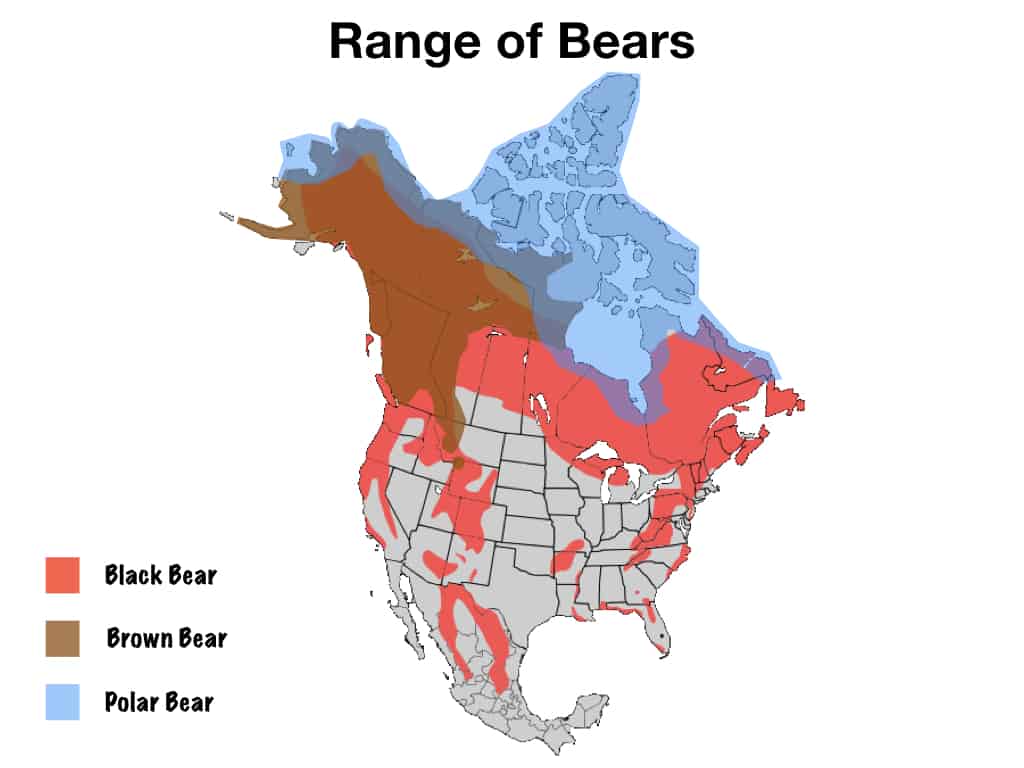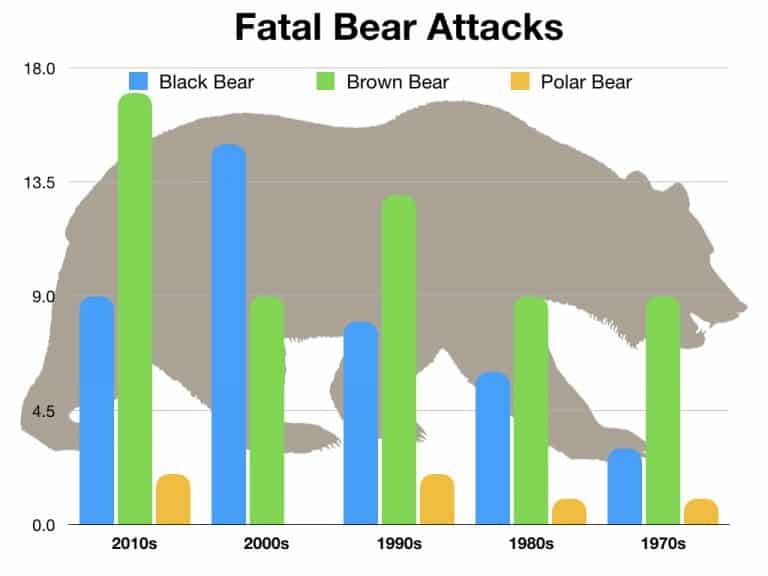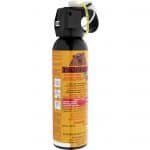Camping in bear country can seem like a daunting experience especially for beginners. Just imagine crossing paths with a bear while hiking or having one wander into your campsite – What should you do? How should you respond? And why are your pants suddenly wet?
All jokes aside, the more important question is how do you prevent or minimize bear encounters in the first place. Well, if you follow some simple yet effective techniques, you can dramatically reduce the chances of a bear encounter from ever happening while camping.

Understanding Bear Behaviour
Understanding bear behavior, patterns and natural instincts will definitely help you plan and prepare for camping in bear country.
Things That Attract Bears
Bears typically hibernate during the winter months when food is scarce. The rest of the year they are on a constant quest for food to increase their fat reserves for lean times.
To find food, they use their highly sensitive sense of smell to sniff out wild berries, nuts, seeds, edible plants, fruits and fish. Occasionally, bears will hunt other land animals as small as rabbits and as large as elk. They are also scavengers and will eat dead animals too.
Bears are naturally attracted to human activity. Scents from cooking, hygiene products and garbage are invisible beacons calling out to bears. They will frequent areas where humans have visited if edible remnants are left behind since this can be a substantial food source for them.
Similarly, human waste (the number two kind) can attract bears too. It’s important to dispose of your poop properly while in the woods. This means making a proper latrine and ensuring it’s far (at least 100 yards) from your campsite.
Are Bears Afraid of Humans?
Yes, most bears are wary of humans and keep their distance. Instinctually they realize we are a threat and will try to avoid us. So, by making lots of noise while hiking or camping, you can help ensure bears within earshot hear you and stay away.
However, the odd nuisance or predatory bear will encroach into human areas usually in search of food or prey (aka. You!). These bears have lost their natural fear of humans. Whether it’s driven by hunger or has slowly built a tolerance over time, these bears are responsible for impacting campers.
They are bold and brash, and some can even become aggressive. Without intervention, these bears will continue to roam freely in areas frequented by people and the odds of a deadly encounter increases dramatically.
Nuisance and predatory bears must be reported to campground officials and other campers immediately. If they can’t be scared off, then they will have to be relocated. And, as a last resort, some bears must be destroyed for repeat offences, aggressive behaviour or injuring people.
Bear Encounter Statistics
Although there are close to 900,000 bears roaming North America, they are mostly relegated deep into the wilderness. Your chances of encountering a bear while camping highly depends on the region you are camping. The region also dictates what species of bear you are likely to encounter.
Population and Range of Bears
Of the three species of bear that exist in North America, the American black bear is most common and has the largest range. Brown bears, also referred to grizzly bears, are less common than black bears. Brown bears are mostly found in Northwestern Canada and Alaska but can also be found in small pockets around the continental United States. Polar bears only account for around 3% of the total bear population. They roam the arctic regions of northern Alaska, Canada and all of Greenland.


Bear Attack Statistics
Because bears tend to avoid humans, most encounters usually result in the bear and humans walking away unharmed. However, there are a limited number of bear encounters every year that are deadly.
The graph below depicts the number of bear attacks by species in North America over the past several decades. Over the years, there has been a steady rise in the number of fatal attacks. This is mostly due to an increase in human populations in bear country and a shrinking bear habitat.

It’s evident from the numbers that brown bears are more dangerous than black bears since brown bears are the culprit of a majority of the attacks reported. Surprisingly, black bears, which account for over 73% of the bear population, only account for less than 40% of all fatal attacks. But, this doesn’t make them any less dangerous!
How to Respond When You Encounter a Bear
If you encounter a bear, either on the trail or at your campsite, there are many factors that will influence whether an attack will occur. Responding quickly and correctly, depending on the situation, can be a matter of life or death. The right response can stop an attack from happening altogether or lessen the impact on you.
How Do Bears React During an Encounter
When you encounter a bear, it might do one of the following:
- Walk/run away
- Stand its ground
- Charge towards you
If the first two things happen, back away from the area while keeping an eye out for the bear in the direction it fled or is standing. Once you are far enough away, contact park officials to notify them of a bear in the area. Park rangers may close the area and track down the bear to ensure it is no longer a threat.
If in the case a bear charges towards you, it may be a bluff charge or an aggressive charge. These two types of charges are very different and mean very different things.
Bluff Charge
A bluff charge is meant to frighten or intimidate. When a bear bluff charges, its head and ears remain up and forward. Like a cat, a bear will puff itself up to appear bigger. It will bounce on its front paws while it moves towards you and stop suddenly or run off to one side.
- If a bluff charge is imminent, back away slowly. Calmly speak to the bear while waving your hands above your head.
- During a bluff charge, hold your ground. Remain calm.
- Once the bluff charge is complete, back away slowly while calmly speaking to the bear.
- DO NOT RUN during a bluff charge because it might trigger an attack.
Here’s an excellent video showing multiple bluff charges by a black bear:
Aggressive Charge
Where a bluff charge can be somewhat benign, an aggressive charge can be deadly. Yawning, teeth clacking, front paws pounding while huffing are all indicators that a bear is anxious and ready to charge. Their body language also changes. Its head will be lowered and ears will be pointed backwards much like an attack dog.
Black Bear Attacks
- If a black bear charges and attacks, FIGHT BACK! Do not play dead.
- Target the bear’s face. Kick, punch or use bear spray, rocks, or sticks to protect and defend yourself.
Brown Bear Attacks
- If a brown bear charges and attacks, DO NOT FIGHT BACK! Play dead.
- Protect your head and neck with your arms.
- Lay flat, on your stomach.
- Remain still and do not make noise.
- If the attack stops, wait several minutes until you are sure the bear is long gone before getting up.
- If the attack persists, fight back with everything you have! It’s life or death at that point.
This great video clearly explains how to respond to bear encounters and echoes a lot of the points mentioned above:
Bear Spray and Firearms
Both bear spray and firearms are effective at stopping bear attacks. However, bear spray is widely considered a superior tool compared to firearms.
Here’s are some reasons why bear spray is better than firearms:
- Using a firearm to target a charging bear is more difficult compared to a spray cloud
- A shot and wounded bear can become more aggressive and dangerous
- Bear spray is easier to deploy with far less training compared to a firearm
- Bear spray is non-lethal, whereas a firearm can be lethal
Bear Attack FAQ
Should I climb a tree to escape a bear attack?
No! Bears are incredible climbers. They can climb trees extremely fast and can chase you up a tree if they want. Instead, find shelter in a car or building if possible.
Can I outrun a bear?
A 250 kg (550 lbs) grizzly bear can run at a top speed of 56 km/h (35 miles/hour). The fastest man on earth, Usain Bolt, can run at a top speed of 45 km/h (28 miles/h). Dude, don’t run.
What if a bear is stalking me?
A stalking bear is usually displaying predatory-like behavior which can be very dangerous. Essentially, an attack is imminent and you are the prey. If you can’t seek shelter in a car or building immediately, you need to be ready to fight back.
- Once you notice a bear is stalking you, retrieve your bear spray and prepare to deploy it.
- If you do not have bear spray, use other weapons to fight. Rocks, sticks, a knife and your fits can be used.
- During a predatory attack, regardless of bear species, FIGHT BACK!
Can regular pepper spray be used as bear spray?
No! Personal protective or police sprays are not effective against a charging bear. They shoot out a narrow stream instead of a dispersed cloud. Think of it like using a can of silly string against a raging fire. It won’t be affective.
Instead, you’ll need to purchase and carry an EPA-approved bear spray. It’s more potent and shoots a dispersed cloud which makes it easier to target a charging bear. Always check with parks regarding their bear spray policies.
For more information regarding bear encounters, check out this awesome video highlighting all the topics covered above plus more:
10 Helpful Tips for Camping in Bear Country
1. Select a Proper Campsite

Before and during your camping trip, select appropriate campsites that are safe and clear of any intrinsic bear-related hazards:
- Look for bear or other animal activity
Claw marks on trees, scat, paw prints and tuffs of fur are all tell-tale signs of bear and other animal activity. This means they frequent the campsite often and it’s more likely they will visit again.
- Avoid berry patches, fruit trees and animal trails
Bears actively seek wild berries and fruits throughout the year. Before setting up your campsite, scan the surrounding area for berry patches and fruiting trees. The sweet smell can attract bears from miles away.
Likewise, animal trails should also be avoided, if possible. Bears and other wildlife tend to use these trails to quickly and efficiently move through the bush. You’re more likely to come across a bear on an animal trail than randomly in the bush.
- Avoid camping next to rivers
Setting up camp next to a raging river can be risky since the rushing water masks the sounds you make as well as noises from an approaching bear. If possible, setup camp 50 to 100 yards from a river so that the noise dissipates. And when travelling to and from the river, scan the area for bears and make lots of noise to make your presence known.
2. Prepare, Cook and Eat Food Away from Your Tent

It’s essential that when in bear country you prepare, cook and eat food far from your tent. That way you will prevent food scraps and scents from contaminating where you sleep when you are the most vulnerable.
Following these tips for cooking and eating food:
- Cook and store food a minimum of 100 yards away from your tent
- NEVER bring food inside your tent
- Waste water from cleaning dishes should be disposed of far from your tent
- Collect and dispose of all food scraps
- Pack all garbage out
3. Use Storage Lockers to Store Scented Items

Some campgrounds and campsites have built-in storage lockers for food and scented items storage. These lockers are made from metal and use a latch system that is impervious to bears.
When you aren’t cooking, store all food and food related equipment in a storage locker. Also, any scented items such as deodorant, drink powders, or packaged foods should be kept safe in the locker.
Set up your campsite far from the locker as it may be frequented by animals throughout the day and night. Do not leave garbage in these lockers.
4. Hang Food or Use a Bear-proof Container

In some parks and campgrounds, all food must be either hung from a tree or kept in a bear-proof container.
Hanging food ensures it remains out of the reach of bears and other ground dwelling animals. Ropes can be used to lift and tie food containers at least 4 meters off the ground. The container must also hang at least two meters from any tree trunk.
If trees are sparse or it is impossible to hang food at the minimum height requirements, a bear-proof container can be used instead. The design and materials of bear-proof containers ensures they can survive even the most relentless of bears. These containers are to be left on the ground far from your tent.
For more information on proper food storage, check out this article on How to Properly Store Food While Camping.
5. Plan Meals to Avoid Leftovers

Leftover food can be a huge problem when camping, especially in bear country. Yes, you can find ways of disposing of it, however the best approach is to not have any left overs in the first place.
Removing leftovers boils down to proper meal planning. Before heading out, measure and calculate the amount of food you will make per meal. If you end up making more that what you are able to eat, modify the recipe to reduce the portion size.
6. Store Cookware and Utensils with Food

The scent of food tends to linger on cookware, no matter how well it is cleaned. Spices, fats and oils cooked into utensils also can attract keen nosed bears.
That’s why storing all cookware and utensils with similar precautions of food is important. If your food container is large enough, simply pack all food related equipment inside. Alternatively, storage lockers can be used, or items can be placed in a bag and hung.
7. Carry Bells, Whistles and an Air-horn
While hiking on trails and at your campsite, it’s important make noise to broadcast your presence to any bears and animals in your vicinity. Bears will most likely relocate away from you and your group once they hear your coming.
Whistling, talking, tapping trees and stomping the ground are all good ways to make noise in the backcountry. I always add bells to my pack which rattles around as I walk. I also add bells to my dog’s collar, so she makes noises as she walks.
Whistles are also good to keep on hand. New backpacks have whistles built into the chest strap. These whistles can be used on the trail to ward off animals, and to signal to others of danger.
An air-horn is also a great tool that can be used to scare off a bear when confronted. The sudden loud sound can spook a bear which makes them a great non-lethal and non-injuring deterrent. Just remember that if an air-horn has to be used, keep bear spray close at hand.
8. Bring Bear Spray
Bear spray has been proven to be an effective self-defence against bear attacks. The powerful chemicals can stop even the most aggressive bears dead in their tracks.
Bear spray is easy to use and quick to deploy. It should always be kept on your person, either on a belt holster or chest strap. It should never be packed in a backpack which can dramatically delay your reaction time.
When you are confronted by a bear, you should follow the steps outlined in the section above (How to Respond When You Encounter a Bear). If the bear does not immediately flee or begins to show aggressive behavior, get ready to deploy the spray. Remove the safety and aim. If the bear charges, deploy the bear spray and target the face.
Bear spray is a last resort item in your arsenal of self-defence. But if used correctly, it can end up saving your life.

Bear Spray Canister
Effective from up to 35 feet, this EPA approved bear spray delivers a heavy fog for maximum coverage and stopping power! Unfortunately, you can't buy this on Amazon. Instead, you can visit your local sporting goods retailer and they should have it in stock.
9. Bear Cubs are Cute; Mother Bears are Fierce

Bear cubs are cute furry little fluff balls. They are curious and inquisitive and tend to stray away from their mother and fellow cubs. But, no matter how strong the urge is to approach one of them, chances are its mother is within close proximity. And, if you get too close for comfort, momma bear can suddenly attack with the ferocity of a Roman gladiator.
So, if you are hiking and find yourself in between a mother bear and her cubs, back away slowly. Do not run. As you exit the area, make your presence known.
If you see a cub but cannot locate its mother, get out your bear spray and be prepared to deploy. A mother bear can appear suddenly and come charging at you. Remember, it is only doing because it perceives you as a threat. Respect their space and you’ll walk away with a great story.
Also, it goes without say but, DO NOT FEED BEARS! They are great hunters and scavengers and don’t need our help.
10. Keep Dogs Leashed

I’ve been camping with my dog Shilo for the past 13 years. When we’re roaming though the backcountry, or hiking on a trail, I always keep her on leash.
Even the most aggressive and dominating dog is no match for a full sized bear. So, having complete control of your dog when you encounter a bear is very important. It prevents your dog from approaching the animal and you maintain the ability to control your dog’s movement if you need to act quickly.
There have been cases where a dog has flushed out a bear hidden in the bush. In some cases, the bear starts to chase the dog and the dog leads the bear right into humans who aren’t prepared for the encounter.
Likewise, at your campsite, ensure your dog is on leash so that it doesn’t wander off and sniffs out a wandering bear.
Source of Information
If you’d like to learn more about bear encounters, I highly recommend checking out the following sources:
- https://www.nps.gov/articles/bearsprayfirearms.htm
- https://www.nps.gov/articles/bearattacks.htm
- https://en.wikipedia.org/wiki/List_of_fatal_bear_attacks_in_North_America
- http://commons.wikimedia.org/wiki/File:American_Black_bear_map.png
- https://en.wikipedia.org/wiki/File:Ursus_arctos_horribilis_map.svg
- https://geology.com/stories/13/bear-areas/
This article contains affiliate links, which help support this blog at no cost to you!
